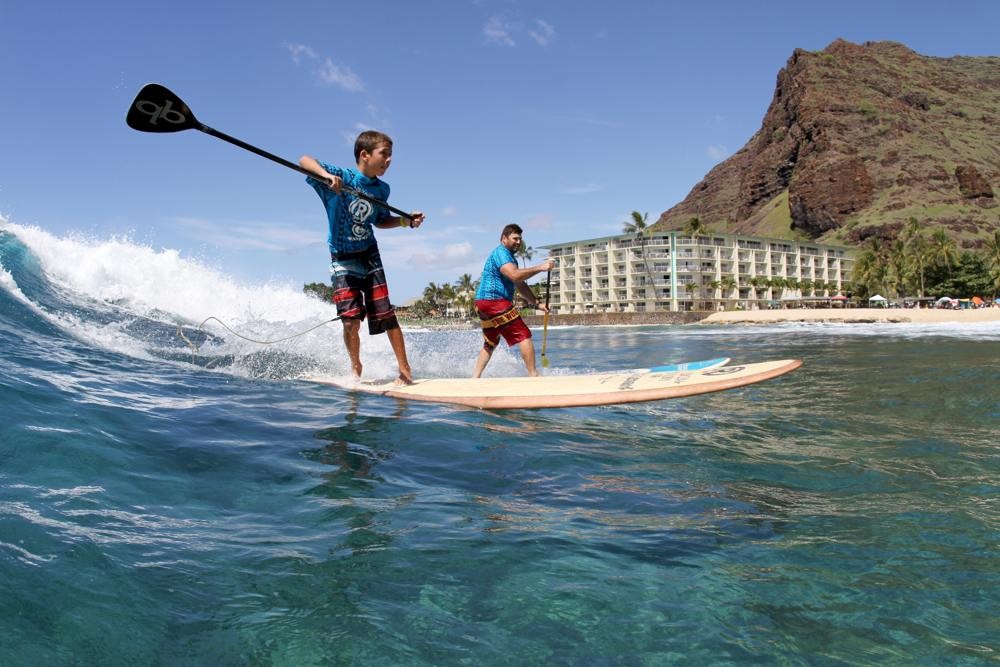- Details
- Written by: Mike Walker
Stand Up Paddleboarding, or SUP, has come a long way from its traditional Hawaiian roots – these days you can see folk paddling around stretches of the coast that rarely have surf, gliding serenely on lakes and even commuting to work on a board on the Thames.
At first glance it appears to be quite a relaxing activity, akin to canoeing while standing up, with the added frisson of catching a small wave from time to time; at its most extreme, however, it’s as radical as any other branch of surfing, with top exponents such as living Hawaiian surf legend Laird Hamilton taking on waves in excess of 40 feet on his board.
Stand-up paddle surfing is thought to have been practiced by the ancient Hawaiians and Polynesians, and had its heyday in Hawaii in the 1960s, when experienced surfers would use the board and paddle combination to ride the small waves at Waikiki, which roll gently shorewards for hundreds of metres and are perfect for surfing on these relatively bulky surf craft.
The sport was actually known as ‘beachboy surfing’ at this time (nothing to do with the California crooners, most of whom couldn’t actually surf), but it virtually died out until Laird Hamilton and a few fellow big-wave surfers such as Dave Kalama and Bruce DeSoto took it up in the early noughties. There are now international competitions in Hawaii and the sport is spreading rapidly around the world’s surf nations. SUP is also popular in plenty of places without waves, since it’s a great way to get around on any body of water, waves or no waves.
At its purest you use a bladed paddle to cruise into the waves with ease – the combination of extra flotation and added paddling power makes catching and riding waves considerably easier than on a regular surfboard.
That said it’s a lot harder than it sounds and as with regular surfing you’ll spend far more time falling off at first, but once you have the hang of it you’ll look remarkably cool and elegant as you stand on your four-metre board and stroke out through the shore-break to paddle into the waves with style.
“It’s a great option for flat or small days, and when you get it wired you can have a lot of fun in bigger surf,” says Martin Connolly, head honcho at Discovery Surf School in South Devon, which was the first surf school in Britain to teach SUP.
“I also use it for keeping in shape and even to ‘explore’ the local coastline and the estuary,” adds Connolly, who has plenty of experience of paddle surfing in both the UK and Hawaii.
Your first lesson will last a couple of hours and will be as exhausting as it is thrilling. Starting with the basics of standing on a stationary board you’ll then soon progress to getting it moving with your paddle. With any luck, by the second session you’ll be paddling into your first tiddly waves and, small as they may be, there’s a real buzz to gliding smoothly down the face of the wave thanks to your skilled paddling.
SUP is a great sport for British waters – we get lots of flat days, even in established surfing areas such as Cornwall and South Wales, but with a stand up paddle board you can have fun in the tiniest of waves, and when the swell does pick up the challenge becomes even greater.
The thrill factor comes all at once as you feel your paddle strokes being matched by the speed of the swell then find yourself being caressed into the smooth, inviting face of a wave. Succeed in pulling off a turn to ride along the wave face and the sense of excitement and achievement is complete.
Experienced surfers will obviously pick it up quite quickly, but even if you’ve never ridden a board of any sort you’ll have fun on your first day – in fact as Martin Connolly says, ‘Coming to the sport without any preconceptions can be an advantage, and anyone who is fit and a good swimmer, kids especially, should be able to pick it up.’
And as we already mentioned, SUP isn’t just for riding waves; you can use your board to explore the coastline on flat days, or simply paddle on your local lake or river – you see a lot more when you’re standing up than you do sitting down in a canoe or kayak!
WEBSITES
discoverysurf.com
bsupa.org.uk – official site of the British Stand Up Paddle Association




